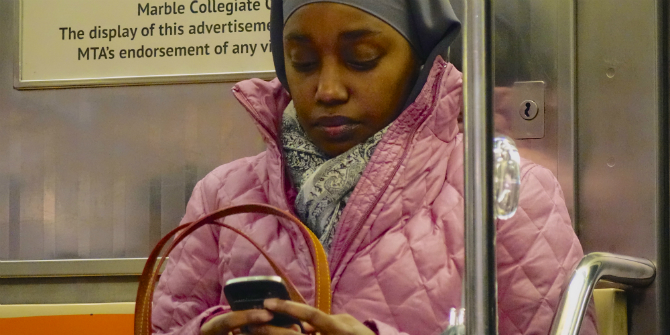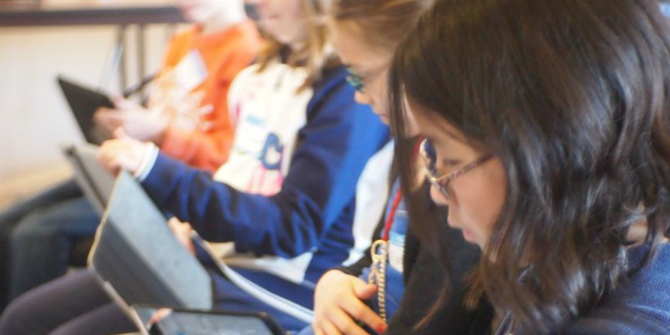 The internet is now 30 years old, making it the same age as the key formulation of children’s rights, the UN Convention on the Rights of the Child. In the intervening years, our understanding of the transformative effects of the internet on both society and children have developed in tandem. In this post Sonia Livingstone outlines some of the issues raised by the internet in relation to children rights and what we may learn from children themselves on this subject. Finally, she remarks on the opening of the consultation period for the UN’s General Comment on The Rights of the Child in the Digital Environment, inviting readers to join this debate. Sonia Livingstone is Professor of Social Psychology at LSE’s Department of Media and Communications.
The internet is now 30 years old, making it the same age as the key formulation of children’s rights, the UN Convention on the Rights of the Child. In the intervening years, our understanding of the transformative effects of the internet on both society and children have developed in tandem. In this post Sonia Livingstone outlines some of the issues raised by the internet in relation to children rights and what we may learn from children themselves on this subject. Finally, she remarks on the opening of the consultation period for the UN’s General Comment on The Rights of the Child in the Digital Environment, inviting readers to join this debate. Sonia Livingstone is Professor of Social Psychology at LSE’s Department of Media and Communications.
The key human rights framework for children is the UN Convention on the Rights of the Child. It has been visionary, authoritative, comprehensive and influential. Yet it was written in 1989, when the internet was just beginning and its significance much underestimated. So is the Convention fit for the digital age? I have previously argued that the Convention needs updating. However, this was not entirely serious, as the Convention has been carefully phrased to apply broadly across time and place, while allowing for local application. But undoubtedly there are growing uncertainties over how to interpret and implement it in relation to the digital environment.
A mounting set of threats to children’s safety and wellbeing is leading to a widespread clamour that something must be done – think of, among many other instances; the web streaming of child sexual abuse and exploitation, the massive data breaches of children’s personal data via the Internet of Toys, or the explosion in ‘fake news’ along with multifarious covert forms of persuasion – as with the case of self-harm messaging on Instagram.
Something indeed must be done. However, it’s important that this doesn’t undermine the many positives of internet access for children too – think of the educational possibilities, as children gain access to many kinds of information, along with the civic and political possibilities for young citizens, not to mention the sheer pleasure, sociability and fun of many online activities.
A holistic, balanced approach is greatly needed, one that respects these wider benefits and doesn’t just try to manage ad hoc problems as they arise. This should begin by listening to children, as is their right under article 12 of the Convention. Children have plenty to say about the upsides and downsides of the internet, and about what should be done. They call for internet access, digital literacy and greater support, recognising the huge breadth of ways in which the digital world is reconfiguring their wellbeing and life changes:
‘If someone is sick in the family, we can use the internet to match symptoms to the sickness and determine its severity.’ (Bhutan, girl, 18)
‘It is through the internet that many young people join terrorist groups, because the internet helps but on the other hand it destroys.’ (Central African Republic, boy, 15)
‘Teachers should teach classes that help us use digital technology appropriately.’ (Japan, girl, 17)
These are just a small selection of the wealth of views collected by Amanda Third and her colleagues for UNICEF in 2017. But who’s listening? Five years ago the UN Committee on the Rights of the Child held what’s called a Day of General Discussion on digital media and children’s rights. It concluded that:
‘States should adopt a national coordinating framework with a clear mandate and sufficient authority to coordinate all activities related to children’s rights and digital media and ICTs at cross-sectoral, national, regional and local levels and facilitate international cooperation.’
In the UK we are about to get new regulation, it seems. But what of the global situation? Most children live in the global South, and despite huge problems of poverty and inequality, many of them are getting online in one way or another. Our Global Kids Online project shows that this brings both opportunities to benefit and risks of harm, with children often the ‘canary in the coal mine’ – experiencing life in the digital age before parents, teachers or governments have caught up. UNICEF’s annual State of the World’s Children report in 2017 called on all stakeholders to better realise children’s rights in a digital world. As part of its Strategy on the Rights of the Child, in 2018 the Council of Europe adopted a Recommendation for member states on Guidelines to respect, protect and fulfil the rights of the child in the digital environment. This too is an inspiring document, and one I was proud to contribute to as independent expert consultant.
The UN, however, has universal reach. It also has a particular mechanism at its disposal – the General Comment. As the Child Rights International Network explains, these
… provide interpretation and analysis of specific articles of the CRC or deal with thematic issues related to the rights of the child. General Comments constitute an authoritative interpretation as to what is expected of States parties as they implement the obligations contained in the CRC.
In 2017 we wrote the case for a General Comment for the Office of the Children’s Commissioner. The exciting news is that in 2018, the Committee on the Rights of the Child decided to develop a new General Comment on the Rights of the Child in the Digital Environment. This will take a year or more to develop, including global consultations with experts and, importantly, with children also.
The first consultation is now open – inviting evidence, insights and priorities regarding the role of the digital environment, for better or for worse, in relation to children’s access to information and freedom of expression and thought; right to education and digital literacy; freedom of assembly; right to culture, leisure and play; protection of privacy, identity and data processing; protection from violence, sexual exploitation and other harm; family environment, parenting and alternative care; health and wellbeing.
None of this will be straightforward. The task ahead is to produce a succinct and informative document for States regarding their obligations to realise children’s rights. This will include, significantly, the obligation of the State to ensure that business meets its responsibilities to children’s rights, including by design. As you may imagine, there are plenty of knotty challenges to be faced. As the Committee has put it, key questions include:
- How can children’s views and experiences be expressed and taken into account when formulating policies and practices which affect their access to, and use of, digital technologies?
- How can discrimination (originating offline or online) be effectively addressed, to ensure all children have their rights realised in a digital world?
- How should the General Comment treat the role of parents and other caregivers?
- How should the practices of businesses operating in the digital environment support the realisation of children’s rights?
- How can States better realise their obligations to children’s rights in relation to the digital environment?
- Is the realisation of children’s rights in the digital environment necessary to realise children’s rights in other environments?
Supporting the Committee is our team led by Baroness Beeban Kidron and 5Rights, including me, Amanda Third of the Western Sydney University, Gerison Lansdown, and Jutta Croll of Stiftung Digitale Chancen. We hope as many experts and interested parties as possible will promote the consultation, and make a formal response by 15 May 2019 to the OHCHR website here. Watch this space for updates.
Notes
This post originally appeared on the LSE Impact Blog and it has been reposted here with permission.
This article gives the views of the author, and not the position of the LSE Parenting for a Digital Future blog nor of the London School of Economics and Political Science.





